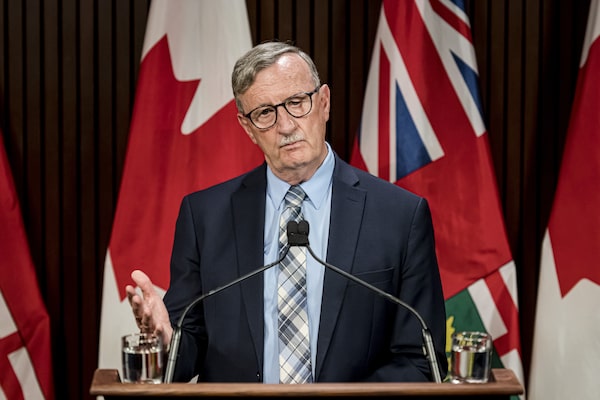
Dr. David Williams, Chief Medical Officer of Health for Ontario at Queen's Park in Toronto, on Aug, 13, 2020.Christopher Katsarov/The Canadian Press
The independent commission examining the devastating impact of the coronavirus on Ontario’s nursing homes grilled the province’s top public-health doctor over his stewardship of the pandemic.
During nearly 4½ hours of testimony on Monday, David Williams, the province’s Chief Medical Officer of Health, was asked why he did not order crowded nursing homes to transfer residents who tested positive for the virus to alternative settings. He was also asked about the slow turnaround times for COVID-19 test results – some homes received results by mail – and why the province does not have an updated pandemic plan.
Commission lawyer John Callaghan asked Dr. Williams if he had read the testimony describing for the inquiry how Hong Kong has dealt with crowded conditions in its nursing homes and kept the coronavirus at bay.
Terry Lum, associate director of the Sau Po Centre on Ageing at the University of Hong Kong, said the homes transferred not only a resident who tested positive but everyone else who came in contact with that resident to a quarantine centre for 14 days. They only moved them back after they had tested negative.
COVID-19 news: Updates and essential resources about the pandemic
Dr. Williams said he did not read Dr. Lum’s testimony, describing him as “one scientist giving his input,” according to a transcript released on Thursday.
The commission itself has joined a growing chorus of voices calling for transferring residents who test positive for COVID-19 to alternative settings. It recommended in October that residents in older homes be given the option to temporarily move to avoid further transmission of the virus.
Dr. Williams testified that he considered the idea but said there were no facilities available. Mr. Callaghan countered that private companies, including Bruce Power, offered to put up field hospitals.
“Surely we have the facilities, correct?” he said.
“We have facilities, but you haven’t got the staff,” Dr. Williams said.
Many nursing homes in Ontario lack the capacity to properly isolate residents ill with the virus from the healthy. Almost 40 per cent of the province’s homes have multibed wards. A previous Globe and Mail analysis found that 36 homes where residents sleep in the same room and share a bathroom with two or three other people accounted for 55 per cent of the province’s long-term care deaths during the spring.
An inability to cohort residents was not the only challenge for long-term care homes dealing with outbreaks. The commission has also heard testimony from hospital executives, who say they could have saved lives in long-term care homes had they received test results faster.
During a lengthy back and forth with Dr. Williams about whether labs could produce more timely results, Mr. Callaghan said: “I’m just trying to get a straight answer from that question.”
The commission has faced delays from the provincial government in obtaining information central to its investigation. It did not receive 2,000 pages of Dr. Williams’s notes until last Saturday – two days before he testified. Many of the pages were redacted.
The commission has also heard that government officials in Ontario started working on a pandemic plan in 2016 but never completed it. Asked if he was aware that Shelley Deeks, chief health protection officer at Public Health Ontario, has testified that she had no idea what plan the province was operating under, Dr. Williams responded: “She was not the head of pandemic preparedness.”
Premier Doug Ford’s government has frequently defended Dr. Williams against criticism from many health experts. On Thursday, Health Minister Christine Elliott told reporters that she has every confidence in Dr. Williams. “He’s done a lot to guide us through some very, very difficult times,” she said.
During the second wave of the pandemic, 1,894 people have died in long-term care homes in Ontario – a toll that exceeds fatalities of 1,848 last spring. The number of active resident infections has dropped dramatically in recent days to 105 from a peak of 1,650 on Jan. 14.
Our Morning Update and Evening Update newsletters are written by Globe editors, giving you a concise summary of the day’s most important headlines. Sign up today.
 Karen Howlett
Karen Howlett